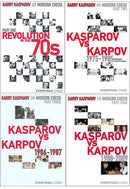Description
Garry Kasparov on Modern Chess Part 1, 2, 3 and 4 (All 4 Books)
Hardbacks, 1698 pages combined!
The history of sport has seen many great gladiatorial clashes: Ali v Frazier in boxing, McEnroe v Borg in tennis, Prost v Senna in motor racing. None however can quite compare to the intensity of the rivalry between those two great world chess champions: Garry Kasparov and Anatoly Karpov. Between 1984 and 1990 they contested an astonishing five World Championship matches consisting of 144 individual encounters.
The period after 1990 was also a fascinating one in the chess world as it witnessed the emergence of a new generation of young grandmasters capable of challenging the supremacy of the 'two K's'. Between them these two greats had dominated the chess landscape for the previous two decades and it has seemed unthinkable that a major tournament could be won by a different player. Now, however, grandmasters such as Viswanathan Anand, Vassily Ivanchuk, Nigel Short, Boris Gelfand, Vladimir Kramnik and Veselin Topalov arrived on the scene and proved themselves capable of competing successfully at the very highest levels.
This period also witnessed an increasing disatisfaction amongst the world elite with the traditional ruling body, FIDE (the World Chess Federation). This led to attempts by the leading grandmasters to organise the World Championship cycle outside of FIDE's jurisdiction. In the late 1980s the Grandmasters Assocation (GMA) was created and was responsible for the organisation of the World Cup - a tournament championship of the world's leading chess players. Another organisation, the Professional Chessplayers Association (PCA) followed in 1993.
Part 1 ,
Part 2 ,
Part 3 ,
Part 4 ,
ISBN-13: 9781857444223, 9781857444339, 978-1857446258 & 978-1857446524 (4 books), Everyman Chess
Hardbacks, 1698 pages combined!
The history of sport has seen many great gladiatorial clashes: Ali v Frazier in boxing, McEnroe v Borg in tennis, Prost v Senna in motor racing. None however can quite compare to the intensity of the rivalry between those two great world chess champions: Garry Kasparov and Anatoly Karpov. Between 1984 and 1990 they contested an astonishing five World Championship matches consisting of 144 individual encounters.
The period after 1990 was also a fascinating one in the chess world as it witnessed the emergence of a new generation of young grandmasters capable of challenging the supremacy of the 'two K's'. Between them these two greats had dominated the chess landscape for the previous two decades and it has seemed unthinkable that a major tournament could be won by a different player. Now, however, grandmasters such as Viswanathan Anand, Vassily Ivanchuk, Nigel Short, Boris Gelfand, Vladimir Kramnik and Veselin Topalov arrived on the scene and proved themselves capable of competing successfully at the very highest levels.
This period also witnessed an increasing disatisfaction amongst the world elite with the traditional ruling body, FIDE (the World Chess Federation). This led to attempts by the leading grandmasters to organise the World Championship cycle outside of FIDE's jurisdiction. In the late 1980s the Grandmasters Assocation (GMA) was created and was responsible for the organisation of the World Cup - a tournament championship of the world's leading chess players. Another organisation, the Professional Chessplayers Association (PCA) followed in 1993.
ISBN-13: 9781857444223, 9781857444339, 978-1857446258 & 978-1857446524 (4 books), Everyman Chess
Payment & Security
Your payment information is processed securely. We do not store credit card details nor have access to your credit card information.


